ACC2005 - Budgetary Slack: Causes, Impacts & Org Factors
VerifiedAdded on 2023/04/23
|8
|2125
|256
Essay
AI Summary
This essay provides a comprehensive overview of budgetary slack within the context of management accounting. It defines budgetary slack as the over-estimation of expenses and underestimation of revenue in budgets, often driven by factors such as budget emphasis, information asymmetry, and budgetary participation. The paper explores how organizational factors like power distance, budget participation, and budget emphasis influence the creation of budgetary slack. High power distance can decrease trust, while budget participation offers opportunities for slack creation. The essay also highlights the interplay between information asymmetry, budget participation, and budget emphasis, suggesting that these factors, combined with power distance, significantly encourage budgetary slack. The analysis emphasizes that budgetary slack arises from the tension between achieving budgeted targets and safeguarding against potential risks, ultimately affecting the competitive positioning and profitability of a business. Desklib offers a range of similar solved assignments and resources for students.
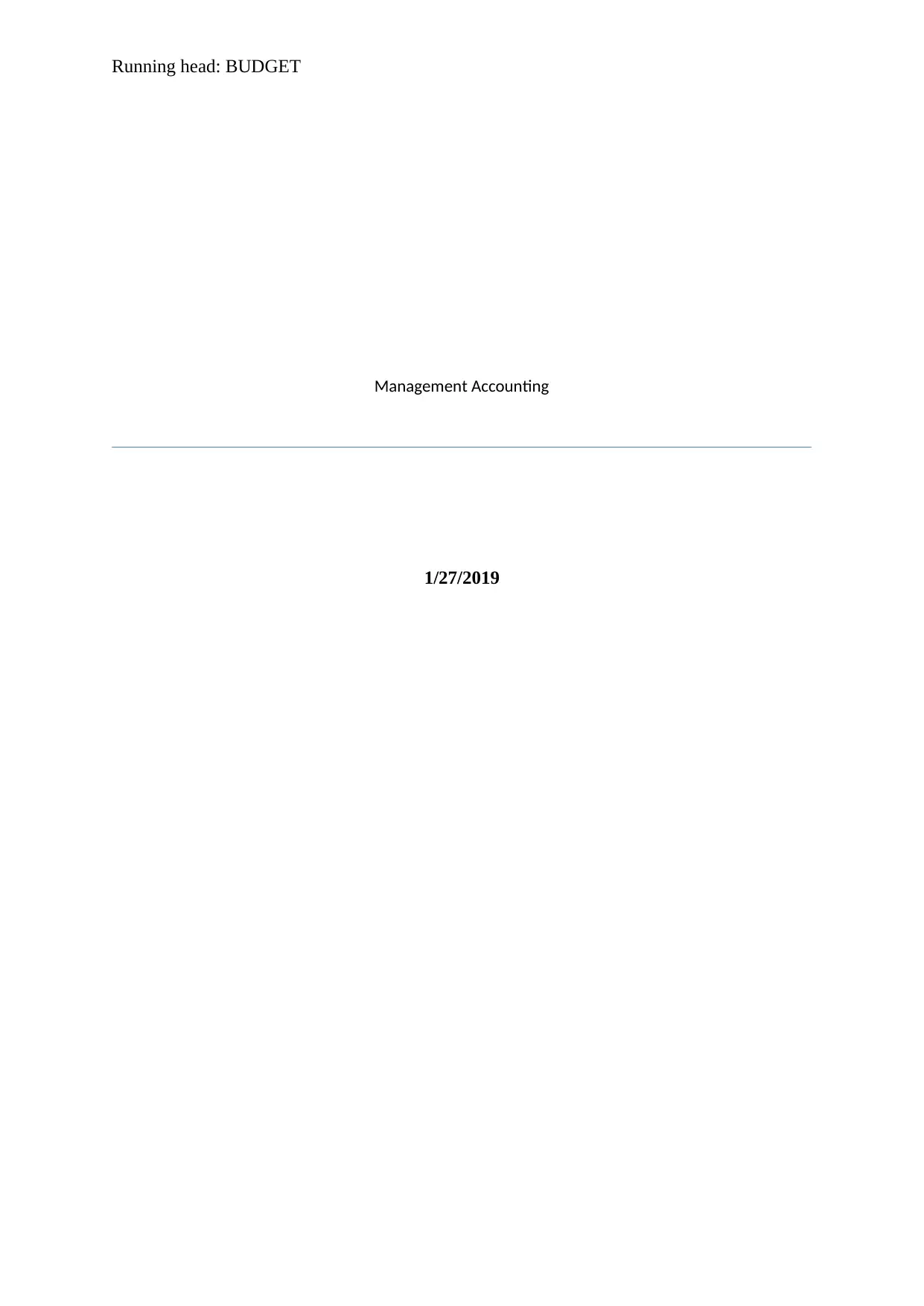
Running head: BUDGET
Management Accounting
1/27/2019
Management Accounting
1/27/2019
Paraphrase This Document
Need a fresh take? Get an instant paraphrase of this document with our AI Paraphraser
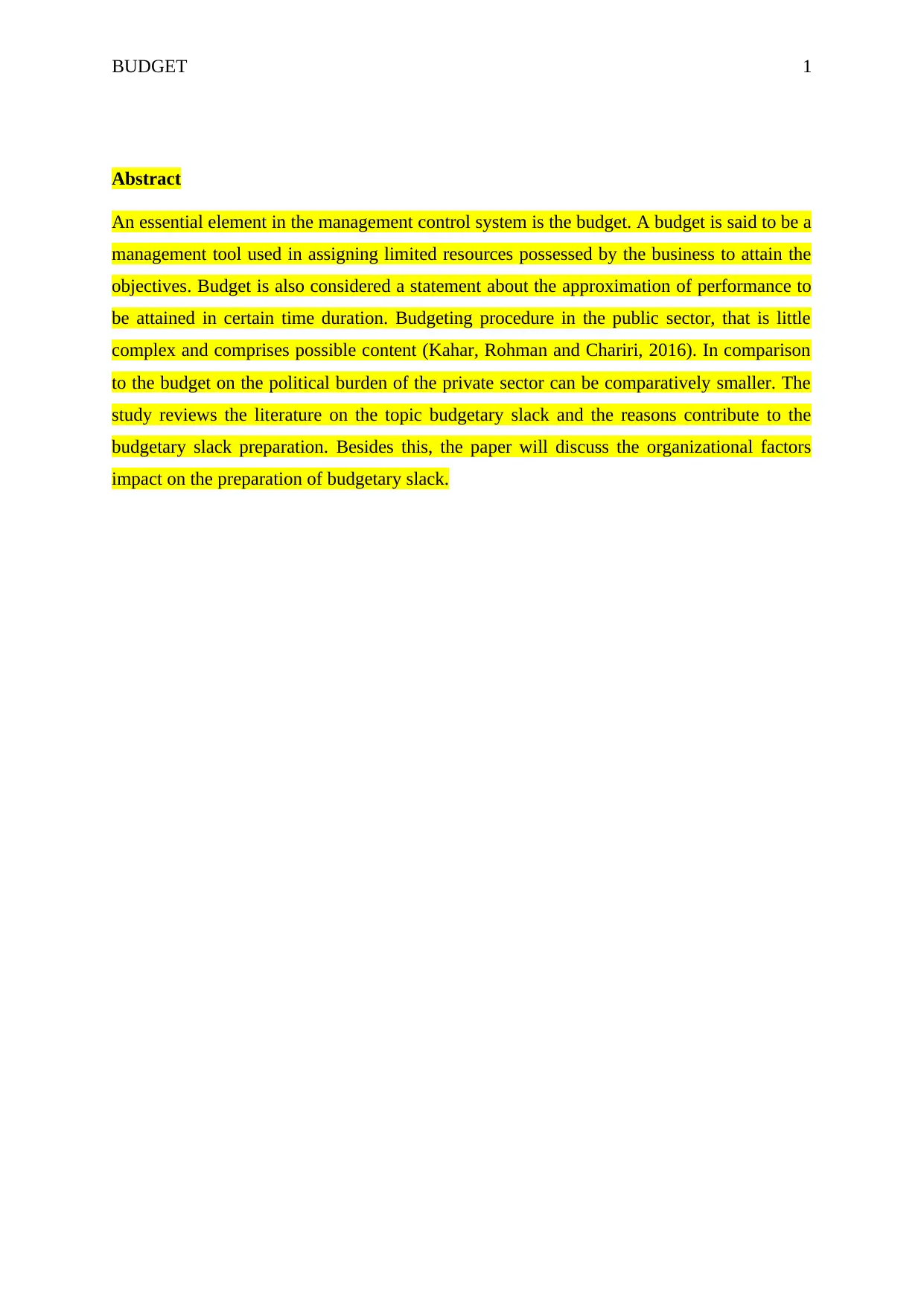
BUDGET 1
Abstract
An essential element in the management control system is the budget. A budget is said to be a
management tool used in assigning limited resources possessed by the business to attain the
objectives. Budget is also considered a statement about the approximation of performance to
be attained in certain time duration. Budgeting procedure in the public sector, that is little
complex and comprises possible content (Kahar, Rohman and Chariri, 2016). In comparison
to the budget on the political burden of the private sector can be comparatively smaller. The
study reviews the literature on the topic budgetary slack and the reasons contribute to the
budgetary slack preparation. Besides this, the paper will discuss the organizational factors
impact on the preparation of budgetary slack.
Abstract
An essential element in the management control system is the budget. A budget is said to be a
management tool used in assigning limited resources possessed by the business to attain the
objectives. Budget is also considered a statement about the approximation of performance to
be attained in certain time duration. Budgeting procedure in the public sector, that is little
complex and comprises possible content (Kahar, Rohman and Chariri, 2016). In comparison
to the budget on the political burden of the private sector can be comparatively smaller. The
study reviews the literature on the topic budgetary slack and the reasons contribute to the
budgetary slack preparation. Besides this, the paper will discuss the organizational factors
impact on the preparation of budgetary slack.
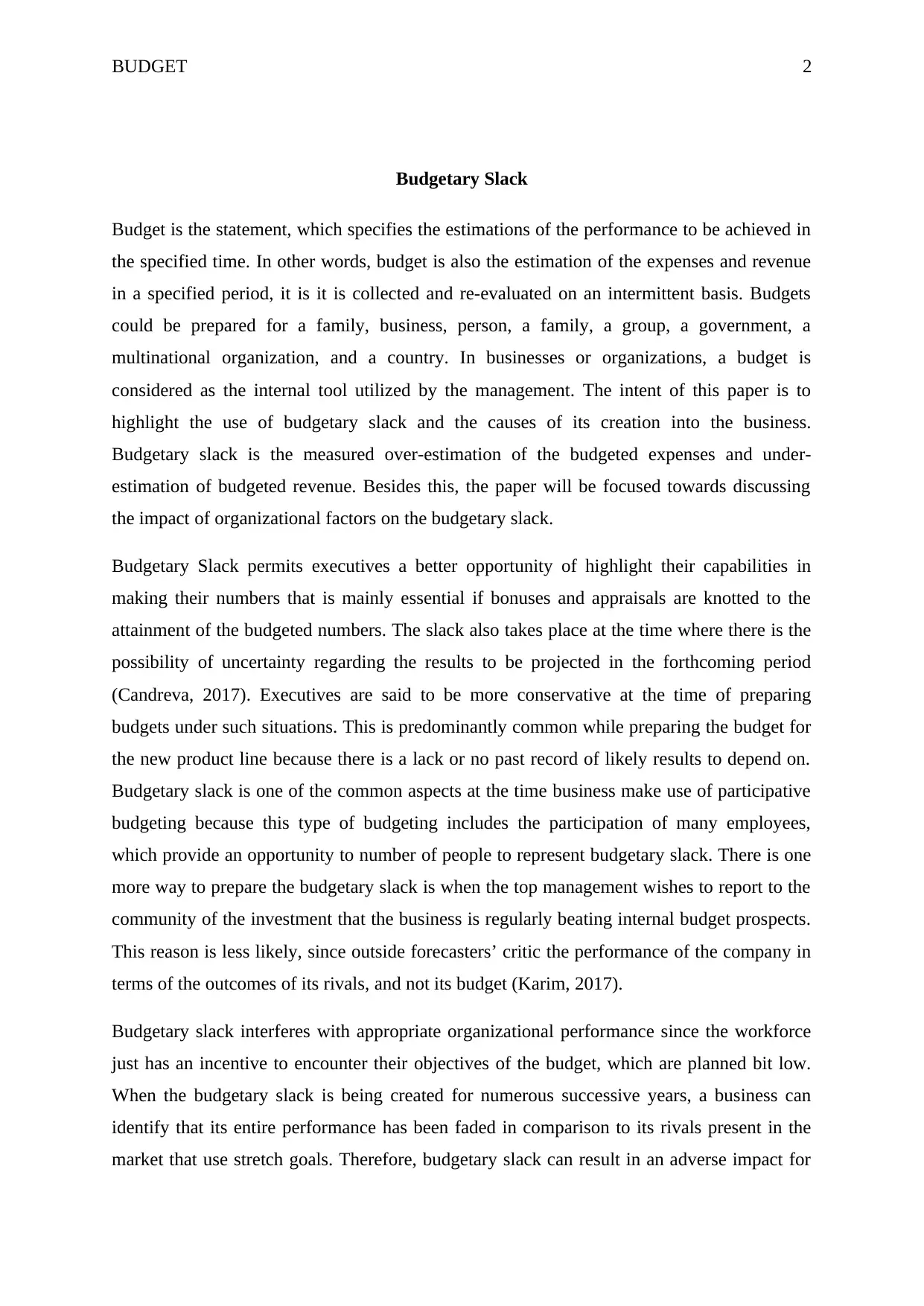
BUDGET 2
Budgetary Slack
Budget is the statement, which specifies the estimations of the performance to be achieved in
the specified time. In other words, budget is also the estimation of the expenses and revenue
in a specified period, it is it is collected and re-evaluated on an intermittent basis. Budgets
could be prepared for a family, business, person, a family, a group, a government, a
multinational organization, and a country. In businesses or organizations, a budget is
considered as the internal tool utilized by the management. The intent of this paper is to
highlight the use of budgetary slack and the causes of its creation into the business.
Budgetary slack is the measured over-estimation of the budgeted expenses and under-
estimation of budgeted revenue. Besides this, the paper will be focused towards discussing
the impact of organizational factors on the budgetary slack.
Budgetary Slack permits executives a better opportunity of highlight their capabilities in
making their numbers that is mainly essential if bonuses and appraisals are knotted to the
attainment of the budgeted numbers. The slack also takes place at the time where there is the
possibility of uncertainty regarding the results to be projected in the forthcoming period
(Candreva, 2017). Executives are said to be more conservative at the time of preparing
budgets under such situations. This is predominantly common while preparing the budget for
the new product line because there is a lack or no past record of likely results to depend on.
Budgetary slack is one of the common aspects at the time business make use of participative
budgeting because this type of budgeting includes the participation of many employees,
which provide an opportunity to number of people to represent budgetary slack. There is one
more way to prepare the budgetary slack is when the top management wishes to report to the
community of the investment that the business is regularly beating internal budget prospects.
This reason is less likely, since outside forecasters’ critic the performance of the company in
terms of the outcomes of its rivals, and not its budget (Karim, 2017).
Budgetary slack interferes with appropriate organizational performance since the workforce
just has an incentive to encounter their objectives of the budget, which are planned bit low.
When the budgetary slack is being created for numerous successive years, a business can
identify that its entire performance has been faded in comparison to its rivals present in the
market that use stretch goals. Therefore, budgetary slack can result in an adverse impact for
Budgetary Slack
Budget is the statement, which specifies the estimations of the performance to be achieved in
the specified time. In other words, budget is also the estimation of the expenses and revenue
in a specified period, it is it is collected and re-evaluated on an intermittent basis. Budgets
could be prepared for a family, business, person, a family, a group, a government, a
multinational organization, and a country. In businesses or organizations, a budget is
considered as the internal tool utilized by the management. The intent of this paper is to
highlight the use of budgetary slack and the causes of its creation into the business.
Budgetary slack is the measured over-estimation of the budgeted expenses and under-
estimation of budgeted revenue. Besides this, the paper will be focused towards discussing
the impact of organizational factors on the budgetary slack.
Budgetary Slack permits executives a better opportunity of highlight their capabilities in
making their numbers that is mainly essential if bonuses and appraisals are knotted to the
attainment of the budgeted numbers. The slack also takes place at the time where there is the
possibility of uncertainty regarding the results to be projected in the forthcoming period
(Candreva, 2017). Executives are said to be more conservative at the time of preparing
budgets under such situations. This is predominantly common while preparing the budget for
the new product line because there is a lack or no past record of likely results to depend on.
Budgetary slack is one of the common aspects at the time business make use of participative
budgeting because this type of budgeting includes the participation of many employees,
which provide an opportunity to number of people to represent budgetary slack. There is one
more way to prepare the budgetary slack is when the top management wishes to report to the
community of the investment that the business is regularly beating internal budget prospects.
This reason is less likely, since outside forecasters’ critic the performance of the company in
terms of the outcomes of its rivals, and not its budget (Karim, 2017).
Budgetary slack interferes with appropriate organizational performance since the workforce
just has an incentive to encounter their objectives of the budget, which are planned bit low.
When the budgetary slack is being created for numerous successive years, a business can
identify that its entire performance has been faded in comparison to its rivals present in the
market that use stretch goals. Therefore, budgetary slack can result in an adverse impact for
⊘ This is a preview!⊘
Do you want full access?
Subscribe today to unlock all pages.

Trusted by 1+ million students worldwide
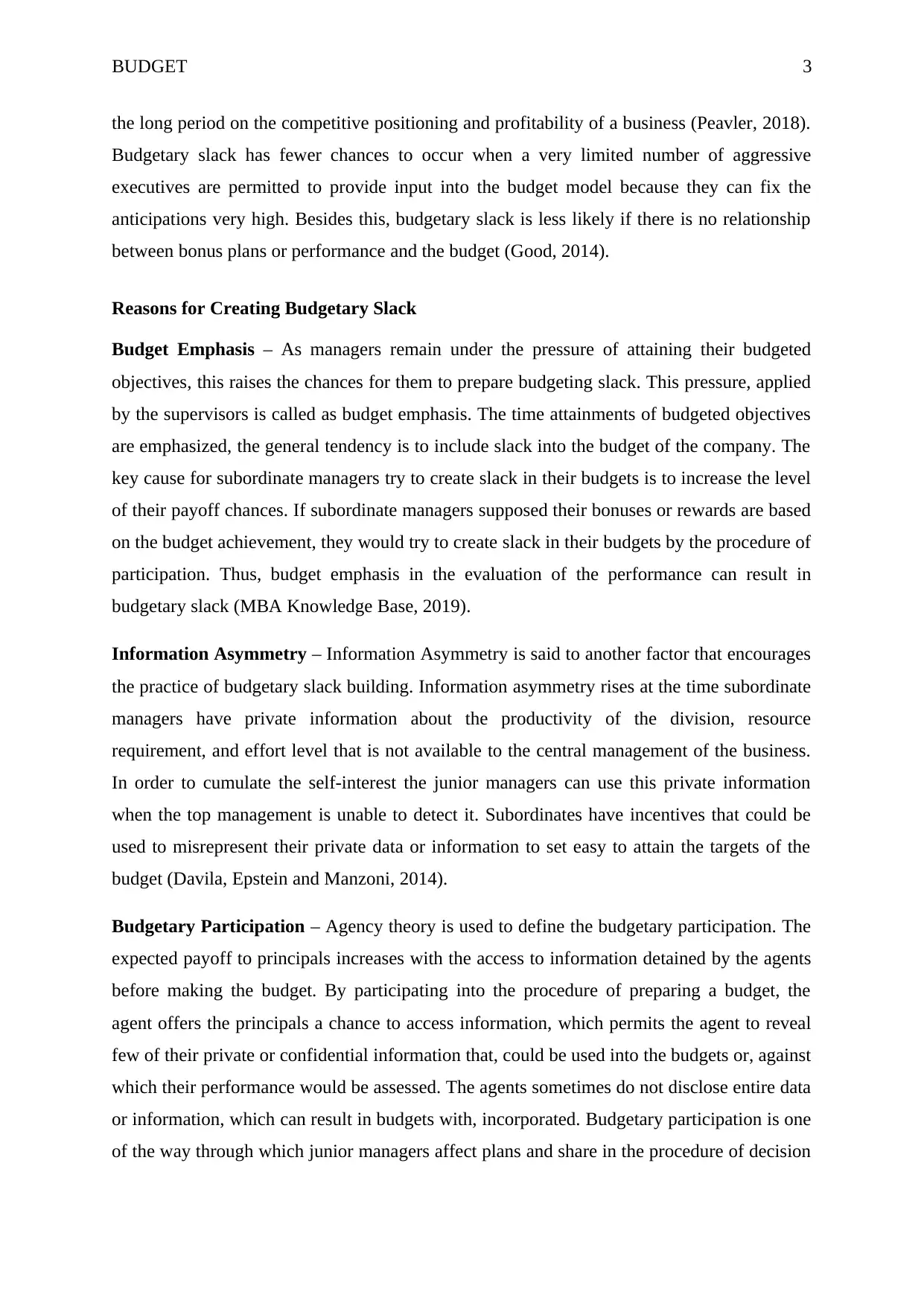
BUDGET 3
the long period on the competitive positioning and profitability of a business (Peavler, 2018).
Budgetary slack has fewer chances to occur when a very limited number of aggressive
executives are permitted to provide input into the budget model because they can fix the
anticipations very high. Besides this, budgetary slack is less likely if there is no relationship
between bonus plans or performance and the budget (Good, 2014).
Reasons for Creating Budgetary Slack
Budget Emphasis – As managers remain under the pressure of attaining their budgeted
objectives, this raises the chances for them to prepare budgeting slack. This pressure, applied
by the supervisors is called as budget emphasis. The time attainments of budgeted objectives
are emphasized, the general tendency is to include slack into the budget of the company. The
key cause for subordinate managers try to create slack in their budgets is to increase the level
of their payoff chances. If subordinate managers supposed their bonuses or rewards are based
on the budget achievement, they would try to create slack in their budgets by the procedure of
participation. Thus, budget emphasis in the evaluation of the performance can result in
budgetary slack (MBA Knowledge Base, 2019).
Information Asymmetry – Information Asymmetry is said to another factor that encourages
the practice of budgetary slack building. Information asymmetry rises at the time subordinate
managers have private information about the productivity of the division, resource
requirement, and effort level that is not available to the central management of the business.
In order to cumulate the self-interest the junior managers can use this private information
when the top management is unable to detect it. Subordinates have incentives that could be
used to misrepresent their private data or information to set easy to attain the targets of the
budget (Davila, Epstein and Manzoni, 2014).
Budgetary Participation – Agency theory is used to define the budgetary participation. The
expected payoff to principals increases with the access to information detained by the agents
before making the budget. By participating into the procedure of preparing a budget, the
agent offers the principals a chance to access information, which permits the agent to reveal
few of their private or confidential information that, could be used into the budgets or, against
which their performance would be assessed. The agents sometimes do not disclose entire data
or information, which can result in budgets with, incorporated. Budgetary participation is one
of the way through which junior managers affect plans and share in the procedure of decision
the long period on the competitive positioning and profitability of a business (Peavler, 2018).
Budgetary slack has fewer chances to occur when a very limited number of aggressive
executives are permitted to provide input into the budget model because they can fix the
anticipations very high. Besides this, budgetary slack is less likely if there is no relationship
between bonus plans or performance and the budget (Good, 2014).
Reasons for Creating Budgetary Slack
Budget Emphasis – As managers remain under the pressure of attaining their budgeted
objectives, this raises the chances for them to prepare budgeting slack. This pressure, applied
by the supervisors is called as budget emphasis. The time attainments of budgeted objectives
are emphasized, the general tendency is to include slack into the budget of the company. The
key cause for subordinate managers try to create slack in their budgets is to increase the level
of their payoff chances. If subordinate managers supposed their bonuses or rewards are based
on the budget achievement, they would try to create slack in their budgets by the procedure of
participation. Thus, budget emphasis in the evaluation of the performance can result in
budgetary slack (MBA Knowledge Base, 2019).
Information Asymmetry – Information Asymmetry is said to another factor that encourages
the practice of budgetary slack building. Information asymmetry rises at the time subordinate
managers have private information about the productivity of the division, resource
requirement, and effort level that is not available to the central management of the business.
In order to cumulate the self-interest the junior managers can use this private information
when the top management is unable to detect it. Subordinates have incentives that could be
used to misrepresent their private data or information to set easy to attain the targets of the
budget (Davila, Epstein and Manzoni, 2014).
Budgetary Participation – Agency theory is used to define the budgetary participation. The
expected payoff to principals increases with the access to information detained by the agents
before making the budget. By participating into the procedure of preparing a budget, the
agent offers the principals a chance to access information, which permits the agent to reveal
few of their private or confidential information that, could be used into the budgets or, against
which their performance would be assessed. The agents sometimes do not disclose entire data
or information, which can result in budgets with, incorporated. Budgetary participation is one
of the way through which junior managers affect plans and share in the procedure of decision
Paraphrase This Document
Need a fresh take? Get an instant paraphrase of this document with our AI Paraphraser
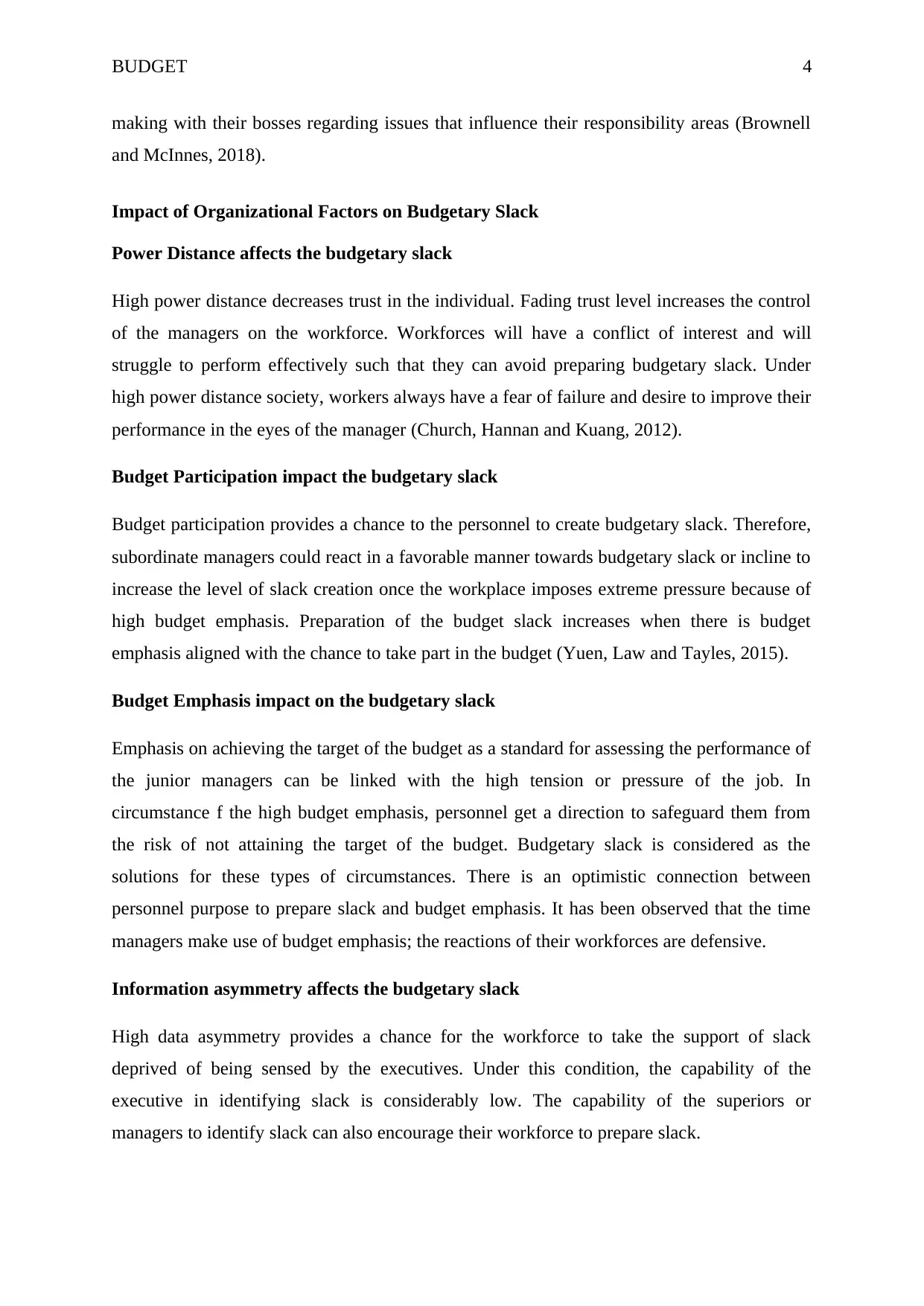
BUDGET 4
making with their bosses regarding issues that influence their responsibility areas (Brownell
and McInnes, 2018).
Impact of Organizational Factors on Budgetary Slack
Power Distance affects the budgetary slack
High power distance decreases trust in the individual. Fading trust level increases the control
of the managers on the workforce. Workforces will have a conflict of interest and will
struggle to perform effectively such that they can avoid preparing budgetary slack. Under
high power distance society, workers always have a fear of failure and desire to improve their
performance in the eyes of the manager (Church, Hannan and Kuang, 2012).
Budget Participation impact the budgetary slack
Budget participation provides a chance to the personnel to create budgetary slack. Therefore,
subordinate managers could react in a favorable manner towards budgetary slack or incline to
increase the level of slack creation once the workplace imposes extreme pressure because of
high budget emphasis. Preparation of the budget slack increases when there is budget
emphasis aligned with the chance to take part in the budget (Yuen, Law and Tayles, 2015).
Budget Emphasis impact on the budgetary slack
Emphasis on achieving the target of the budget as a standard for assessing the performance of
the junior managers can be linked with the high tension or pressure of the job. In
circumstance f the high budget emphasis, personnel get a direction to safeguard them from
the risk of not attaining the target of the budget. Budgetary slack is considered as the
solutions for these types of circumstances. There is an optimistic connection between
personnel purpose to prepare slack and budget emphasis. It has been observed that the time
managers make use of budget emphasis; the reactions of their workforces are defensive.
Information asymmetry affects the budgetary slack
High data asymmetry provides a chance for the workforce to take the support of slack
deprived of being sensed by the executives. Under this condition, the capability of the
executive in identifying slack is considerably low. The capability of the superiors or
managers to identify slack can also encourage their workforce to prepare slack.
making with their bosses regarding issues that influence their responsibility areas (Brownell
and McInnes, 2018).
Impact of Organizational Factors on Budgetary Slack
Power Distance affects the budgetary slack
High power distance decreases trust in the individual. Fading trust level increases the control
of the managers on the workforce. Workforces will have a conflict of interest and will
struggle to perform effectively such that they can avoid preparing budgetary slack. Under
high power distance society, workers always have a fear of failure and desire to improve their
performance in the eyes of the manager (Church, Hannan and Kuang, 2012).
Budget Participation impact the budgetary slack
Budget participation provides a chance to the personnel to create budgetary slack. Therefore,
subordinate managers could react in a favorable manner towards budgetary slack or incline to
increase the level of slack creation once the workplace imposes extreme pressure because of
high budget emphasis. Preparation of the budget slack increases when there is budget
emphasis aligned with the chance to take part in the budget (Yuen, Law and Tayles, 2015).
Budget Emphasis impact on the budgetary slack
Emphasis on achieving the target of the budget as a standard for assessing the performance of
the junior managers can be linked with the high tension or pressure of the job. In
circumstance f the high budget emphasis, personnel get a direction to safeguard them from
the risk of not attaining the target of the budget. Budgetary slack is considered as the
solutions for these types of circumstances. There is an optimistic connection between
personnel purpose to prepare slack and budget emphasis. It has been observed that the time
managers make use of budget emphasis; the reactions of their workforces are defensive.
Information asymmetry affects the budgetary slack
High data asymmetry provides a chance for the workforce to take the support of slack
deprived of being sensed by the executives. Under this condition, the capability of the
executive in identifying slack is considerably low. The capability of the superiors or
managers to identify slack can also encourage their workforce to prepare slack.
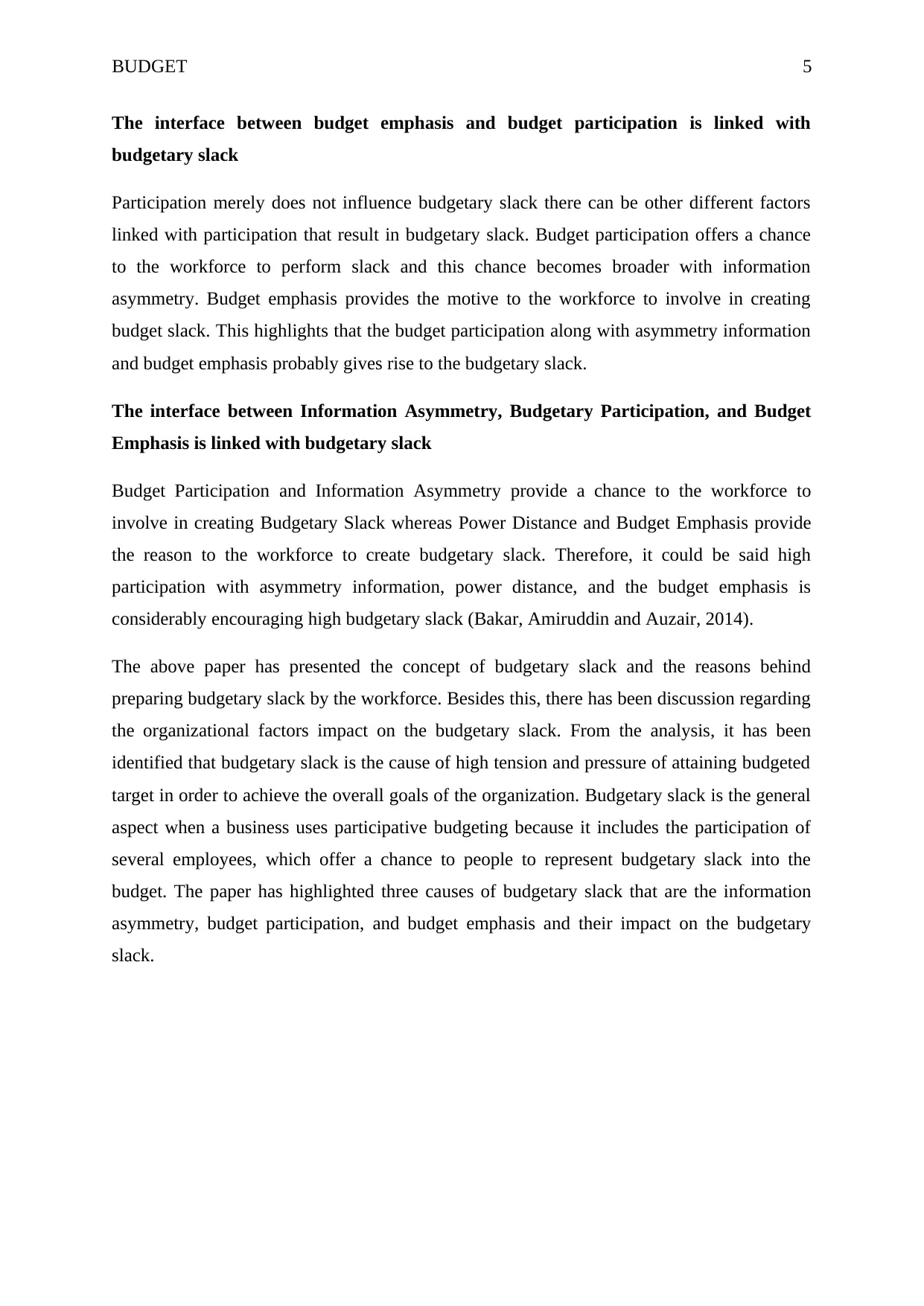
BUDGET 5
The interface between budget emphasis and budget participation is linked with
budgetary slack
Participation merely does not influence budgetary slack there can be other different factors
linked with participation that result in budgetary slack. Budget participation offers a chance
to the workforce to perform slack and this chance becomes broader with information
asymmetry. Budget emphasis provides the motive to the workforce to involve in creating
budget slack. This highlights that the budget participation along with asymmetry information
and budget emphasis probably gives rise to the budgetary slack.
The interface between Information Asymmetry, Budgetary Participation, and Budget
Emphasis is linked with budgetary slack
Budget Participation and Information Asymmetry provide a chance to the workforce to
involve in creating Budgetary Slack whereas Power Distance and Budget Emphasis provide
the reason to the workforce to create budgetary slack. Therefore, it could be said high
participation with asymmetry information, power distance, and the budget emphasis is
considerably encouraging high budgetary slack (Bakar, Amiruddin and Auzair, 2014).
The above paper has presented the concept of budgetary slack and the reasons behind
preparing budgetary slack by the workforce. Besides this, there has been discussion regarding
the organizational factors impact on the budgetary slack. From the analysis, it has been
identified that budgetary slack is the cause of high tension and pressure of attaining budgeted
target in order to achieve the overall goals of the organization. Budgetary slack is the general
aspect when a business uses participative budgeting because it includes the participation of
several employees, which offer a chance to people to represent budgetary slack into the
budget. The paper has highlighted three causes of budgetary slack that are the information
asymmetry, budget participation, and budget emphasis and their impact on the budgetary
slack.
The interface between budget emphasis and budget participation is linked with
budgetary slack
Participation merely does not influence budgetary slack there can be other different factors
linked with participation that result in budgetary slack. Budget participation offers a chance
to the workforce to perform slack and this chance becomes broader with information
asymmetry. Budget emphasis provides the motive to the workforce to involve in creating
budget slack. This highlights that the budget participation along with asymmetry information
and budget emphasis probably gives rise to the budgetary slack.
The interface between Information Asymmetry, Budgetary Participation, and Budget
Emphasis is linked with budgetary slack
Budget Participation and Information Asymmetry provide a chance to the workforce to
involve in creating Budgetary Slack whereas Power Distance and Budget Emphasis provide
the reason to the workforce to create budgetary slack. Therefore, it could be said high
participation with asymmetry information, power distance, and the budget emphasis is
considerably encouraging high budgetary slack (Bakar, Amiruddin and Auzair, 2014).
The above paper has presented the concept of budgetary slack and the reasons behind
preparing budgetary slack by the workforce. Besides this, there has been discussion regarding
the organizational factors impact on the budgetary slack. From the analysis, it has been
identified that budgetary slack is the cause of high tension and pressure of attaining budgeted
target in order to achieve the overall goals of the organization. Budgetary slack is the general
aspect when a business uses participative budgeting because it includes the participation of
several employees, which offer a chance to people to represent budgetary slack into the
budget. The paper has highlighted three causes of budgetary slack that are the information
asymmetry, budget participation, and budget emphasis and their impact on the budgetary
slack.
⊘ This is a preview!⊘
Do you want full access?
Subscribe today to unlock all pages.

Trusted by 1+ million students worldwide
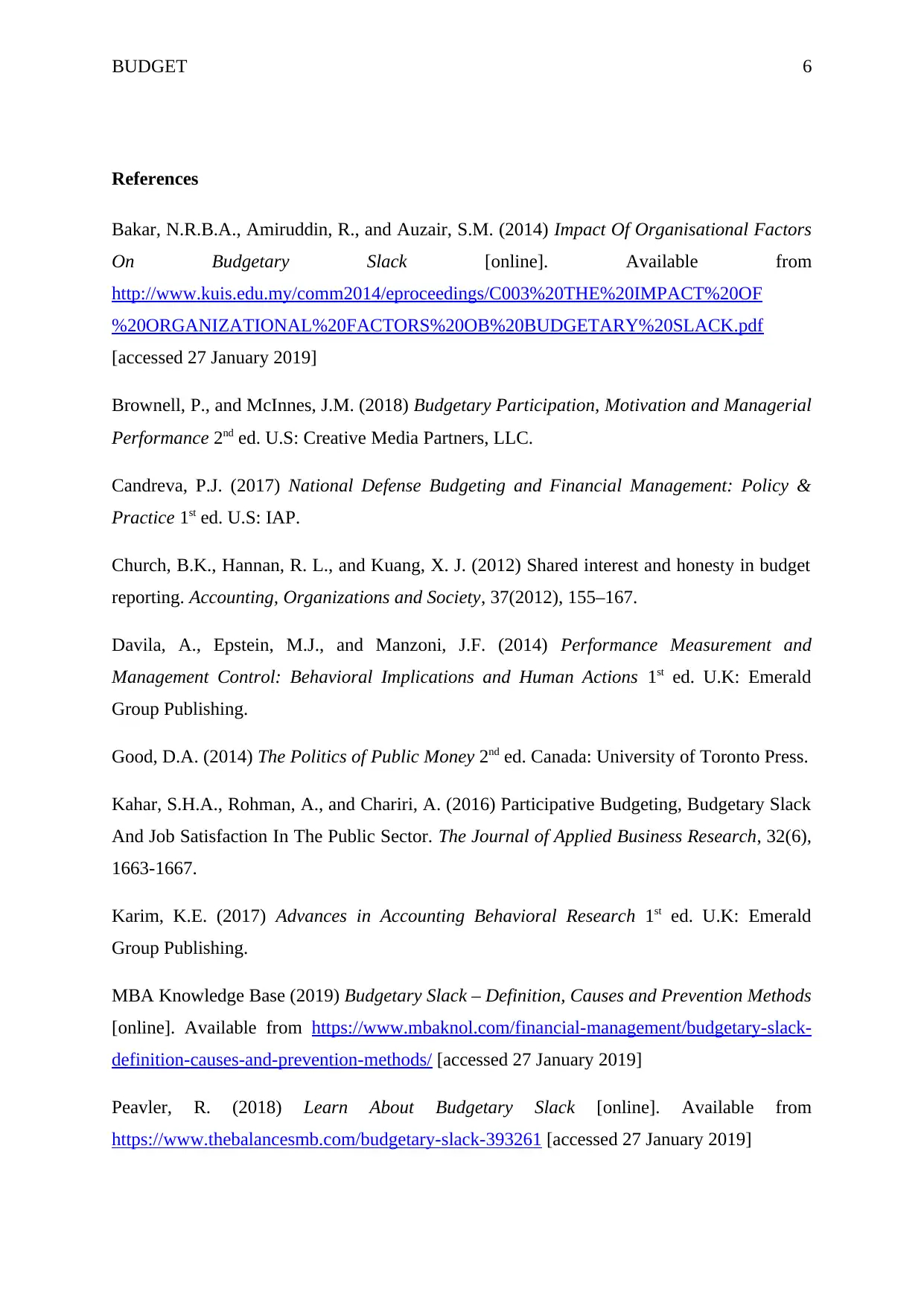
BUDGET 6
References
Bakar, N.R.B.A., Amiruddin, R., and Auzair, S.M. (2014) Impact Of Organisational Factors
On Budgetary Slack [online]. Available from
http://www.kuis.edu.my/comm2014/eproceedings/C003%20THE%20IMPACT%20OF
%20ORGANIZATIONAL%20FACTORS%20OB%20BUDGETARY%20SLACK.pdf
[accessed 27 January 2019]
Brownell, P., and McInnes, J.M. (2018) Budgetary Participation, Motivation and Managerial
Performance 2nd ed. U.S: Creative Media Partners, LLC.
Candreva, P.J. (2017) National Defense Budgeting and Financial Management: Policy &
Practice 1st ed. U.S: IAP.
Church, B.K., Hannan, R. L., and Kuang, X. J. (2012) Shared interest and honesty in budget
reporting. Accounting, Organizations and Society, 37(2012), 155–167.
Davila, A., Epstein, M.J., and Manzoni, J.F. (2014) Performance Measurement and
Management Control: Behavioral Implications and Human Actions 1st ed. U.K: Emerald
Group Publishing.
Good, D.A. (2014) The Politics of Public Money 2nd ed. Canada: University of Toronto Press.
Kahar, S.H.A., Rohman, A., and Chariri, A. (2016) Participative Budgeting, Budgetary Slack
And Job Satisfaction In The Public Sector. The Journal of Applied Business Research, 32(6),
1663-1667.
Karim, K.E. (2017) Advances in Accounting Behavioral Research 1st ed. U.K: Emerald
Group Publishing.
MBA Knowledge Base (2019) Budgetary Slack – Definition, Causes and Prevention Methods
[online]. Available from https://www.mbaknol.com/financial-management/budgetary-slack-
definition-causes-and-prevention-methods/ [accessed 27 January 2019]
Peavler, R. (2018) Learn About Budgetary Slack [online]. Available from
https://www.thebalancesmb.com/budgetary-slack-393261 [accessed 27 January 2019]
References
Bakar, N.R.B.A., Amiruddin, R., and Auzair, S.M. (2014) Impact Of Organisational Factors
On Budgetary Slack [online]. Available from
http://www.kuis.edu.my/comm2014/eproceedings/C003%20THE%20IMPACT%20OF
%20ORGANIZATIONAL%20FACTORS%20OB%20BUDGETARY%20SLACK.pdf
[accessed 27 January 2019]
Brownell, P., and McInnes, J.M. (2018) Budgetary Participation, Motivation and Managerial
Performance 2nd ed. U.S: Creative Media Partners, LLC.
Candreva, P.J. (2017) National Defense Budgeting and Financial Management: Policy &
Practice 1st ed. U.S: IAP.
Church, B.K., Hannan, R. L., and Kuang, X. J. (2012) Shared interest and honesty in budget
reporting. Accounting, Organizations and Society, 37(2012), 155–167.
Davila, A., Epstein, M.J., and Manzoni, J.F. (2014) Performance Measurement and
Management Control: Behavioral Implications and Human Actions 1st ed. U.K: Emerald
Group Publishing.
Good, D.A. (2014) The Politics of Public Money 2nd ed. Canada: University of Toronto Press.
Kahar, S.H.A., Rohman, A., and Chariri, A. (2016) Participative Budgeting, Budgetary Slack
And Job Satisfaction In The Public Sector. The Journal of Applied Business Research, 32(6),
1663-1667.
Karim, K.E. (2017) Advances in Accounting Behavioral Research 1st ed. U.K: Emerald
Group Publishing.
MBA Knowledge Base (2019) Budgetary Slack – Definition, Causes and Prevention Methods
[online]. Available from https://www.mbaknol.com/financial-management/budgetary-slack-
definition-causes-and-prevention-methods/ [accessed 27 January 2019]
Peavler, R. (2018) Learn About Budgetary Slack [online]. Available from
https://www.thebalancesmb.com/budgetary-slack-393261 [accessed 27 January 2019]
Paraphrase This Document
Need a fresh take? Get an instant paraphrase of this document with our AI Paraphraser
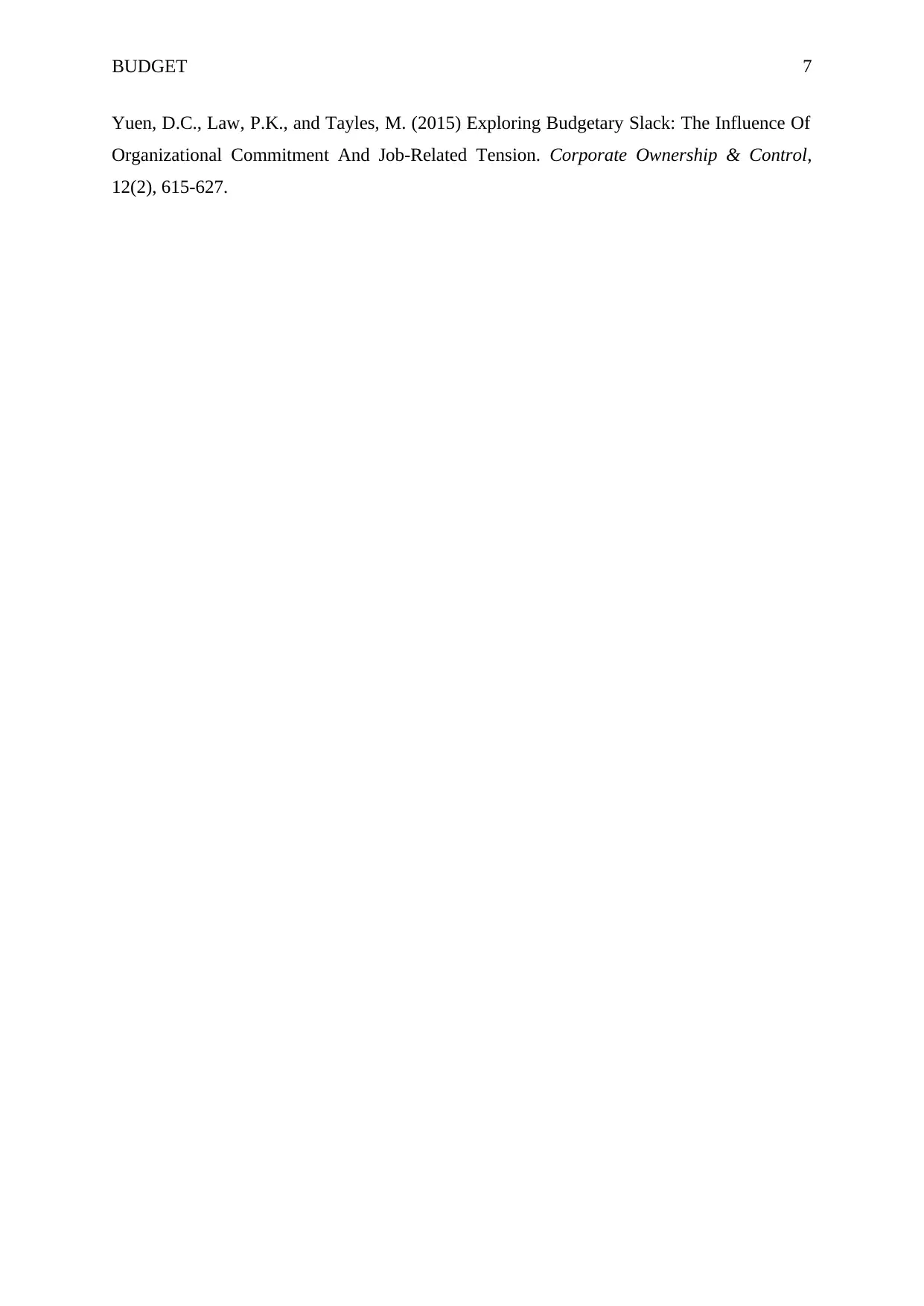
BUDGET 7
Yuen, D.C., Law, P.K., and Tayles, M. (2015) Exploring Budgetary Slack: The Influence Of
Organizational Commitment And Job-Related Tension. Corporate Ownership & Control,
12(2), 615-627.
Yuen, D.C., Law, P.K., and Tayles, M. (2015) Exploring Budgetary Slack: The Influence Of
Organizational Commitment And Job-Related Tension. Corporate Ownership & Control,
12(2), 615-627.
1 out of 8
Related Documents
Your All-in-One AI-Powered Toolkit for Academic Success.
+13062052269
info@desklib.com
Available 24*7 on WhatsApp / Email
![[object Object]](/_next/static/media/star-bottom.7253800d.svg)
Unlock your academic potential
Copyright © 2020–2025 A2Z Services. All Rights Reserved. Developed and managed by ZUCOL.




